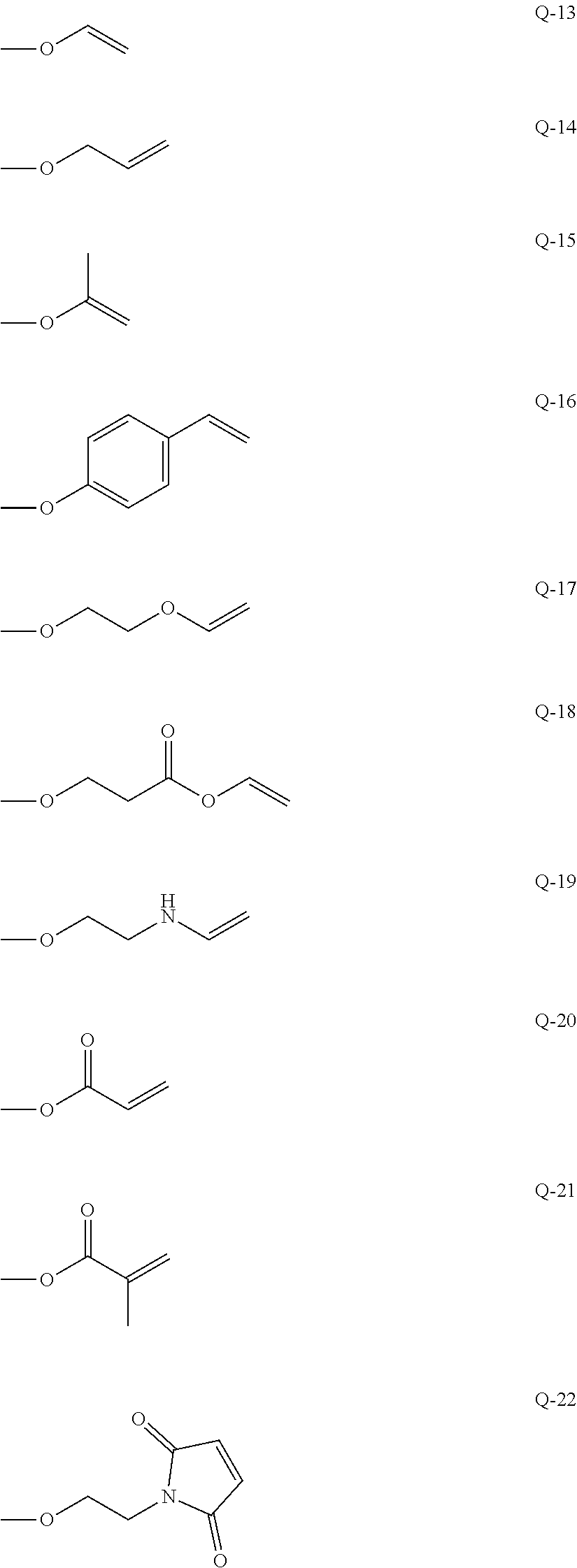Photo-imprinting curable composition and pattern transferring method using the same
a composition and composition technology, applied in the field of photo-imprinting curable composition and pattern transfer method using the same, can solve the problems of dust or bubble defects, substrate separation, pattern collapse, pattern loss, etc., and achieve the effect of little contamination of the pattern mold
- Summary
- Abstract
- Description
- Claims
- Application Information
AI Technical Summary
Benefits of technology
Problems solved by technology
Method used
Image
Examples
synthetic example 1
[Preparation of Polymerizable Compound (A-1)]
[0091]A reaction vessel equipped with a stirrer, a thermometer, a dropping funnel, a condenser tube and a nitrogen gas inlet port was loaded with 20.1 parts phenyltrimethoxysilane, 24.4 parts dimethyldimethoxysilane and 107.7 parts n-butyl acetate. With nitrogen gas aeration, the temperature was increased to 80° C. while performing stirring. Next, with nitrogen gas aeration and while performing stirring at the temperature, a mixture containing 14.5 parts methyl methacrylate, 2 parts n-butyl methacrylate, 105 parts cyclohexyl methacrylate, 7.5 parts acrylic acid, 4.5 parts 3-methacryloyloxypropyl trimethoxysilane, 15 parts 2-hydroxyethyl methacrylate, 15 parts n-butyl acetate and 6 parts tert-butyl peroxy-2-ethylhexanoate was added dropwise to the reaction vessel over a period of 4 hours. Stirring was further performed at the temperature for 2 hours. Thereafter, a mixture containing 0.05 parts isopropyl phosphate and 12.8 parts deionized w...
synthetic example 2
[Preparation of Polymerizable Compound (A-2)]
[0092]Methyl-containing silicone resin KR-500 (trade name, manufactured by Shin-Etsu Chemical Co., Ltd.) (110.8 parts), 2-hydroxyethyl acrylate (58.1 parts) and para-toluenesulfonic acid monohydrate (0.034 parts) were mixed together and heated to 120° C. The reaction was performed for 3 hours while performing stirring and distilling away methanol resulting from the condensation reaction. Thus, 153.9 parts of a polymerizable monomer (A-2) was obtained.
[0093]The compound obtained had the following properties and was thus confirmed to be a polymerizable compound having a silicon atom in the molecule. 1H-NMR (300 MHz, CDCl3) δ (ppm): 6.43 (m, CH═C), 6.13 (m, C═CH—C═O), 5.83 (m, CH═C), 4.25 (br, CH2—O—C═O), 3.96 (br, CH2—O—Si), 3.50 (s, Si—OCH3), 0.15 (s, Si—CH3). The weight average molecular weight was measured to be 1650.
[Preparation of Curable Compositions]
[0094]Compositions of the present invention and comparative compositions were prepare...
PUM
| Property | Measurement | Unit |
|---|---|---|
| size | aaaaa | aaaaa |
| temperature | aaaaa | aaaaa |
| temperature | aaaaa | aaaaa |
Abstract
Description
Claims
Application Information
 Login to View More
Login to View More - R&D
- Intellectual Property
- Life Sciences
- Materials
- Tech Scout
- Unparalleled Data Quality
- Higher Quality Content
- 60% Fewer Hallucinations
Browse by: Latest US Patents, China's latest patents, Technical Efficacy Thesaurus, Application Domain, Technology Topic, Popular Technical Reports.
© 2025 PatSnap. All rights reserved.Legal|Privacy policy|Modern Slavery Act Transparency Statement|Sitemap|About US| Contact US: help@patsnap.com



